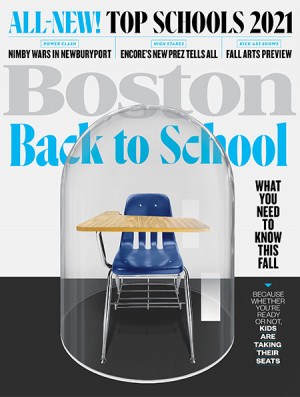Should Your Kid Be Taking Russian Math?
It touts itself as the key to helping your child get a leg up at school and presumably into college. Is this just the latest case of wealthy suburbanites keeping up with the Joneses, or has a Russian woman in Newton figured out a better way to teach to American kids?
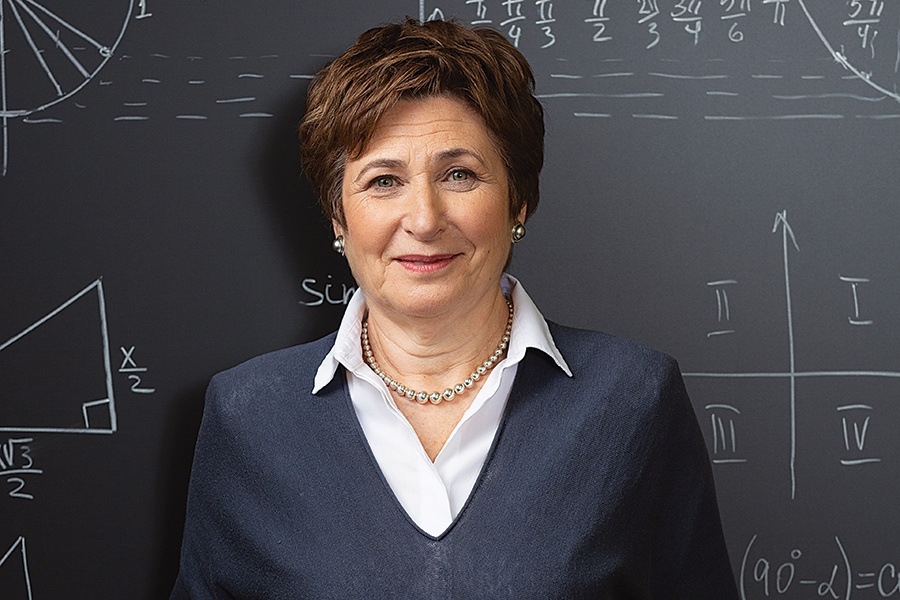
Russian School of Mathematics cofounder Inessa Rifkin started teaching kids extra math at her dining room table in Newton more than 20 years ago. Today, the program has 40,000 students in 53 schools in 12 states, Washington, DC, and Canada, in addition to a booming online program. / Photo by Jason Grow
On a January afternoon at the Russian School of Mathematics headquarters, a 6,500-square-foot bilevel brick building in a Newton corporate office park, Inessa Rifkin leads 15 excitable third and fourth graders through a lesson on graphs. She is in her sixties and chic in a blue-gray tunic over a crisp white button-down, skinny black pants, and a Tiffany-style silver pearl necklace. When she asks a question, her Russian accent unflinching, more than half of the students put their hands in the air. Not a single one has a cell phone on his or her desk. No one’s staring into space.
About halfway through the two-hour class she asks, “Quiz or break?” The group is unanimous in its decision: Quiz it is!
For Rifkin, there are two reasons to celebrate: Not only have the kids willingly chosen a quiz, but just before class began she’d learned that the Russian School of Mathematics—the extracurricular K–12 program she cofounded with fellow Soviet Union expat Irina Khavinson in Newton 22 years ago—had surpassed 40,000 students. RSM has 53 locations in 12 states, Washington, DC, and Canada. Online classes already have students from 24 countries, and are growing faster than Rifkin’s son, Ilya, who is the CEO, can find qualified teachers to teach them.
As the school’s birthplace—but also as a particular hotbed of do-more, get-ahead parenting—Massachusetts is ground zero for Russian Math. Inessa Rifkin estimates that one in four elementary students in Lexington is enrolled in her after-school program; the majority of kids start in second grade and continue through at least eighth, though many go all the way through high school. “I remember we couldn’t believe it when we got 40 students that first year,” she says. Back then, she held classes around her dining room table, and the neighbors complained about the lines of cars coming and going. These days, RSM employs a traffic cop to help keep order during pickup and drop-off at the school’s flagship location, which can accommodate several hundred kids at any given time. “We never even considered ourselves businesswomen,” Rifkin says of herself and Khavinson, acknowledging that they didn’t have a proper business plan until 2009, when Ilya quit his job at a Manhattan hedge fund to join the company at his mother’s urging. “And in this business plan, he wrote we would reach 10,000 students,” Rifkin says. “I laughed. Ten thousand students? From where?”
A decade later, Russian Math is nothing short of a phenomenon. Rifkin and Khavinson have been approached by eager VCs several times over the past 20 years to invest or buy them out and have turned down every offer. Parents of students in Russian Math, meanwhile, note with pride that their kids are two or three years ahead of their peers in math at school, and the company boasts of students’ remarkable scores on standardized tests (a 774 average math score for juniors who take the SAT) and high GPAs in school. The lobby at HQ displays photos of alumni alongside their recent college acceptances: Brown, Dartmouth, MIT, Georgetown.
Still, not everyone thinks the program is the best thing that’s happened to math education since flashcards. Critics say it has questionable academic value to children and is focused more on accelerating students than deepening their understanding of the material. What’s more, there’s growing concern that the significant proportion of students enrolled in Russian Math in some Boston suburbs is having a negative effect on the learning environment inside regular school classrooms. Some see RSM as less of a mathematical miracle and more of an example of savvy marketing colliding headlong into suburban parental panic. “In a prior age, if your child was having trouble in math, you’d hire a tutor, if you had the money,” says Jon Star, an educational psychologist at Harvard who researches math education. “But all these kids who are going to Russian Math aren’t going there because they’re having trouble in math. They’re going there because the public school is not going fast enough for what parents perceive their child needs. So it’s just a very different set of motivations.”
Such behavior can put even more pressure on kids who are already feeling unprecedented levels of anxiety—and on parents to keep up with one another, either for perception or for something to talk about at dinner parties. Newton mother of three Marcela Almeida, whose oldest child started at RSM in third grade, her middle child in first, and her youngest in kindergarten, found herself smack dab in the middle of the rapidly accelerating suburban mathematical arms race. She says she enrolled her kids in RSM even before she’d decided there was anything particularly wrong with the education they were getting for free at the public schools. “I felt a tremendous pressure from our community to send our kids to RSM,” she says. “It appears as though attending RSM is the norm where we live, so I didn’t want them to be behind.”
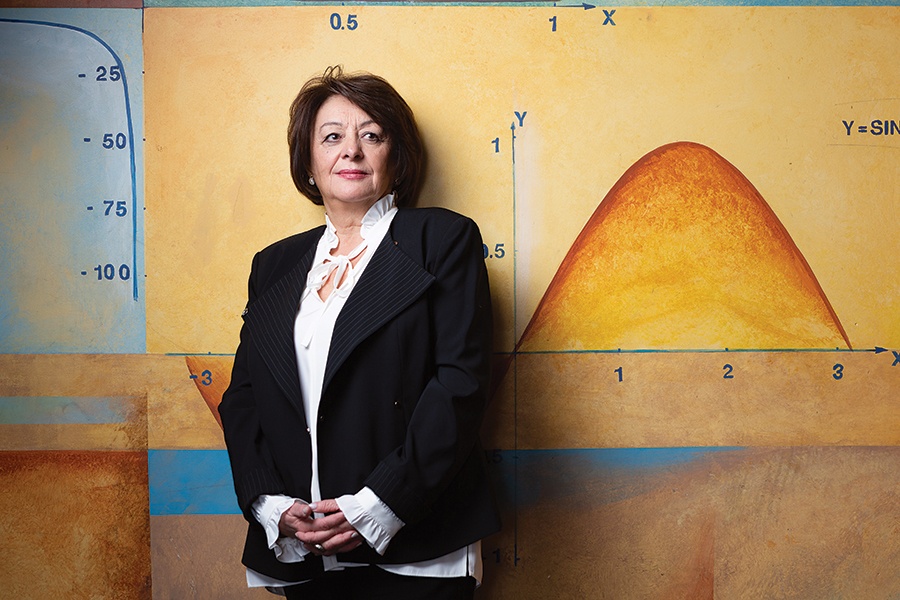
Irina Khavinson worked as a math teacher for 15 years in St. Petersburg before teaming up with Rifkin to found the Russian School of Mathematics. / Photo by Jason Grow
Rifkin came to the United States from the Soviet Union with her husband, Victor, and their two kids, Ilya and Masha, with eight suitcases and $90 in 1988. She got a job as a mechanical engineer at Kronos, a maker of labor-management software. Ilya was in eighth grade when Rifkin says she started to question his motivation in school. His grades were fine, but not great; she assumed he was being lazy. “So I looked at what he was learning,” she says. “The math wasn’t up to my standards. He did not know things I thought he should know by then.” The lessons lacked cohesive flow; they were disconnected from one to the next and the process focused more on getting to the correct answer than understanding how to get there. No wonder Ilya wasn’t motivated, she thought, and of course he and his friends all hated math—the material was prescribed, rote, and very dull. Rifkin started talking to other parents. “Slowly, I came to the realization that it’s not that he’s lazy,” she says. “He takes advantage of everything that’s offered to him. But not much is offered to him.”
Rifkin started tutoring her son and some of his friends after work using lessons she remembered from an elite mathematics school that she’d attended in Minsk. The kids seemed to respond, and she began to think of ways to offer lessons to even more students, envisioning a structured program with teachers who would demand respect from their students and a math curriculum that would make learning fun—and effective. “Not something where someone comes to your house and your child feels like, My parents pay you money so you do what I tell you to do,” which could not be more American, she says.
Her first step: Find a teacher. “I started to ask around, ‘Who knows good teachers from back in the Union?’” she says. In response, a few people told her that somebody told them that somebody had mentioned a woman named Irina. Then 47, Khavinson had been a math teacher for 15 years in St. Petersburg, then known as Leningrad. In Boston, she was working as an accountant and tutoring kids on the side, using a mix of Russian textbooks and lessons she’d developed on her own.
In December 1997, not long after teaming up, Khavinson and Rifkin advertised a meeting at Temple Beth Elohim in Wellesley to talk about the state of their children’s math education. Six hundred people showed up, mostly Russian-Jewish immigrants. Rifkin stood before them and presented her idea for the Russian School of Mathematics. She talked about building a community based on a common need, a place where kids could learn math and play together, and parents could get acquainted with one another. She didn’t have to explain to fellow Russians why math was important. To them, Rifkin says, math is what puts minds in order. What’s more, for immigrant families, STEM is considered a lifeline and the pathway to success in the United States. “I said, ‘We know what good mathematics is. Let’s try to do that here for our kids,’” she recalls. One Newton mom, Olga Dadasheva, stood up and said she recognized the problem, but asked what made Rifkin think she was the one who could solve it. “And I said to her,” Rifkin recalls, “‘You pretty much don’t have any other choice but to let me try.’”
Dadasheva, who arrived in the U.S. from Moscow in 1989 and was working as a software developer, had been looking for math tutoring for her daughter, who was 12 at the time. “It’s easy to criticize American education in general,” Dadasheva says now. “But Russians in particular have this experience where it has to be hard at school. You have to work very hard and get great marks. And that was missing in American schools, where it was more like, ‘If you can do it, that’s great. If you cannot do it, that’s great, do it tomorrow.’”
That night at the temple in Wellesley, Rifkin and Khavinson convinced 60 students to commit, all children of Russian immigrants. Says Rifkin: “It was less a business than a movement.”
Once RSM students (and their peers) started to see the edge they had over the other kids in school, and the confidence that resulted, more kept coming—Russian students, but also children of Chinese and Indian and European immigrants, too. By February 1998, Rifkin had quit her job at Kronos, and by September of that year, RSM had enrolled 150 students and moved to its first commercial location on Beacon Place in Newton, a two-room space on the second floor, over a hair salon. In 1999, Rifkin took out a home equity loan to buy a small white house with blue shutters on busy Centre Street, onto which her husband installed a large sign that read, The Russian School of Mathematics. It was all the advertising they needed, Rifkin says. In no time, the first Americans started showing up.
Biotech entrepreneur Heidi Wyle was one of them. She and her husband had moved to Weston for the good public schools, she says, but teachers were not teaching math the way she thought they should. “We used to joke that in the Weston schools, it was like, ‘No child allowed ahead,’” says Wyle, whose children are now grown and in their twenties. “They were happy to handle the kids who needed help, but they didn’t want these kids who were really bright.”
Wyle was instrumental in introducing RSM to her circle of high-powered, highly educated friends, which included several parents who were professors at Harvard and MIT. But a 2001 article that ran on the front page of the Boston Globe, “A Russian Solution to a U.S. Problem,” was the key to drawing in American families en masse, Rifkin says. “The writer basically drove by on a Sunday morning and saw these kids playing outside the house,” she recalls. He stopped and asked a very cute kid, ‘What are you doing here?’ And the kid said, ‘I’m studying math.’ He said, ‘You’re studying math on a Sunday morning? Why?’ And the kid said, ‘Because I want to get smart and go to MIT.’” The morning after the story ran, Rifkin arrived at the little house on Centre Street to find a line out the door.
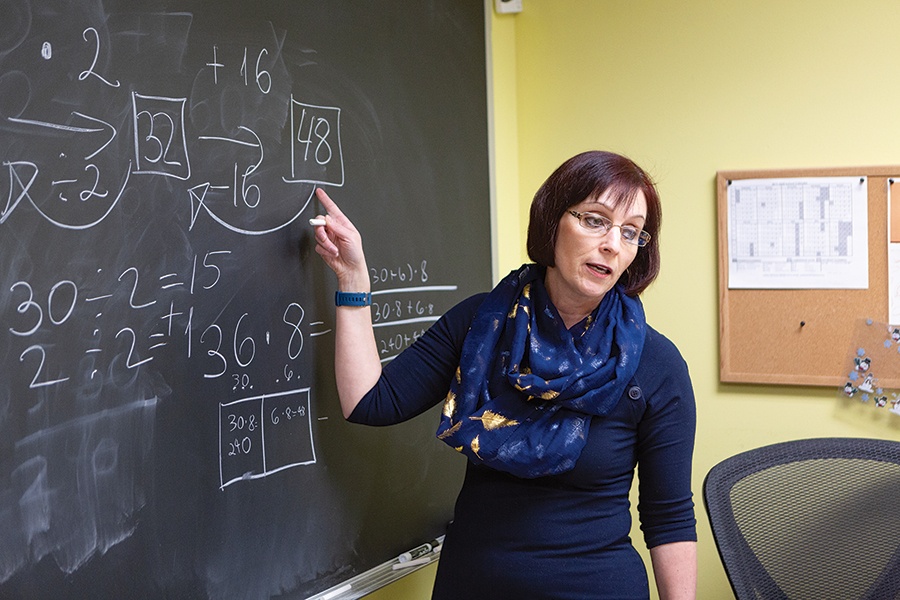
Teacher Irena Burmistrovich instructs a classroom full of engaged students. / Photo by Jason Grow
From the start, Rifkin and Khavinson developed the RSM curriculum in-house, taking some of what Rifkin had used to teach Ilya and some of what Khavinson had used with her students, and then put the first round of tuition payments they received into further developing the coursework. They relied largely on the network of parents gathered that night at Temple Beth Elohim to find Russian émigrés, many of whom worked in academia, to help create lesson plans that emphasized critical thinking and reasoning over memorization. Advanced concepts, such as algebra, were introduced as early as first grade, using age-appropriate approaches and lots of visuals, because according to Rifkin and Khavinson, studies show that kids who learn algebra at an early age have better cognitive development overall. They encourage students to reach calculus by 10th or 11th grade.
Still, Rifkin and Khavinson argue their strategy is not as simple as merely giving students next year’s work. The main difference between Russian Math and the math being taught in schools, they say, boils down to a methodology that emphasizes derivation over memorization—of learning the reasons behind the answers—and a visual approach that helps students “see” the math, and therefore understand it better. Russian Math students also put in more face time with teachers: Since most kids sign up for 90 minutes to four hours a week in concentrated blocks, they theoretically get a chance to understand concepts more deeply. Classes are smaller, too, averaging around 12 students, and divided by ability levels, which means that teachers can teach to students’ very specific needs in a way that public school teachers just can’t. “It’s almost like how you do athletics here,” Rifkin says. “It’s not for your child to become an Olympic finalist. Math for us is not to become a mathematician, but to become a good thinker.”
Wyle, whose kids had also tried the math-enrichment program Kumon but quickly lost interest, remembers being impressed the first time she took her then-first grader to sit in on an RSM class. “They were doing algebra,” she says. “And the way they did it would be, like, two kids balanced on a seesaw. And underneath one kid, there might be the number seven, and underneath the other kid and a weight is a number five. And then they would ask the students, ‘What does the weight weigh?’ and of course the kids would say ‘two’ because they could see it, right? Their whole approach was built around seeing the math, and I myself could sort of see quantum mechanics by the time that class was over. They were teaching kids to see and understand. Not just do.”
Most important, students seem to like it. Newton mom Ellen Chu and her husband initially enrolled their daughter in RSM because she told them she hated math. This year, she started her first year of college at Oxford, majoring in math and computer science. “I think my daughter came to love math because RSM introduced her to more-complex, nuanced math, which she found exciting,” Chu says. “Based on her experience, I think the school is trying to help its students think, problem-solve, and enjoy math.”
Meanwhile, Wyle says RSM’s teachers are warm and invested and create a tightknit community. “Even from the very early days,” she recalls, “when the kids got high SAT scores, when they were merit finalists or stuff like that, for the teachers, it was like our kids were their kids.”
Make no mistake, Russian Math can be an adjustment, especially for students who start when they’re older. Four hours of extra math every week is a lot, and there’s homework, too. Maria Rubio, whose two daughters attended RSM’s Framingham and Wellesley locations and who first heard about the program from a Polish mom at her kids’ bus stop, says her older daughter was moved up a level at RSM after a teacher there said she wasn’t being challenged enough. “The first year, the poor girl,” Rubio says. “They would give her stacks of hundreds of exercises just so she could catch up.” Rubio asked the teacher if she was really sure her daughter was ready. “She told me, ‘I’m not going to keep her in the lower class because, I mean, this is about challenging them,’” Rubio recalls. “‘This is not about anything else. She doesn’t belong there. She has to go to the other level.’ So she struggled but she made it and she became really, really fluent and now I always thank those big stacks of exercises.”
In another success story, Belmont’s Alanna Fincke sent her son to Russian Math last year as an eighth grader at his request. “For Jonah, the way they taught made more logical sense to him than the way it was taught in his public school,” Fincke says. He’d previously attended, and liked, Kumon. And yet, Fincke says, “There was something about Russian Math that just seemed like a challenge, and he really liked that.”
All of the kids I talked to said Russian Math puts them at an advantage in their regular math classes, where they tend to do better on tests—or, at least, they don’t have to study as hard to do okay. Rifkin believes that better grades aren’t all they’re getting: “Grades matter, but they’re also more confident,” she says. “I see this in the girls we teach, especially. They enjoy their smartness tremendously. They’re not shy of being smart, or of having a voice in class. I see them when they start with us and I see them when they leave us and they’re different people.”
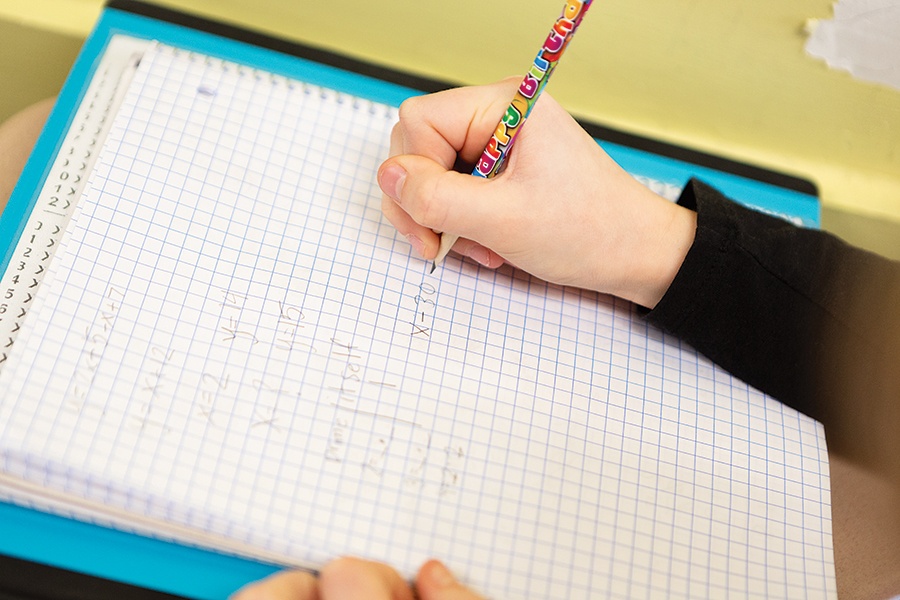
Photo by Jason Grow
Not everyone is convinced, though, that there is anything particularly special going on at Russian Math, other than kids spending four hours a week—or more—working on arithmetic. (In Jonah’s case, his parents even hired a tutor to help him do better in Russian Math, which may be the next level of the mathematical arms race.) Parents may think it is helping their kids, but Harvard’s Jon Star says there is no evidence that enrollment in RSM translates into better grades in schools or better standardized test scores. What’s more, he takes issue with the idea that Russian math is somehow better than the math that’s taught in public schools. In fact, he doesn’t even think it’s demonstrably unique. Part of the RSM sales pitch, Star says, is that its coursework engages students more, and differently, than their normal school curriculum. But he says there’s no universal school of math in Russia that everyone’s following and that is significantly different from what is taught in the U.S. “I’d urge parents to be cautious with that claim,” he says, “because just because the teacher teaches math while speaking with a Russian accent doesn’t make it better.”
What Star suspects is really going on is that Russian Math is merely teaching kids the same math they learn in their regular curriculum, just earlier and faster—which he says is pretty low-hanging fruit in the world of math education.
Meanwhile, Hilary Kreisberg, director of the Center for Math Achievement at Lesley University and a former fifth-grade teacher turned math coach, says her experiences with RSM students have led her to question the claim that Russian Math focuses more on developing a deep understanding of math instead of memorization. In fact, she has seen the opposite. “From what I’ve seen, they come in well above their grade-level standards in terms of memorization, but not in terms of content understanding,” she says. “Many of them very quickly get to an answer or can compute in a fast way, but they can’t necessarily explain to me what they’re doing or why they’re doing it.” And explanations, she says, are a critical component of mathematics. “In public school teaching, we are very strictly taught that the goal is not to accelerate,” Kreisberg says. “The goal is not to extend their thinking into another grade level, but to go deeper with the current grade-level standards because there’s always more you could learn about a topic.”
Many parents, though, love the accelerated curriculum and feel it gives their kids an edge, not just in high school but in the ever more competitive quest for admission to an elite university. Every last one of the dozen-plus RSM parents I spoke with told me that their child was “way ahead” of their regular math class, which they viewed as evidence of a less-than-challenging curriculum and further proof of how far behind American math is.
Star and Kreisberg say this attitude is part of a misguided “race to calculus,” where the view is that the sooner a student gets there, the better. “It’s not about helping your kid get to where they should be in math to really understand the math deeply. It’s about going fast so you can get ahead of everyone else, with the perception that that helps. And for what?” Star asks. “There is zero evidence that it helps your child to take calculus in 10th grade.”
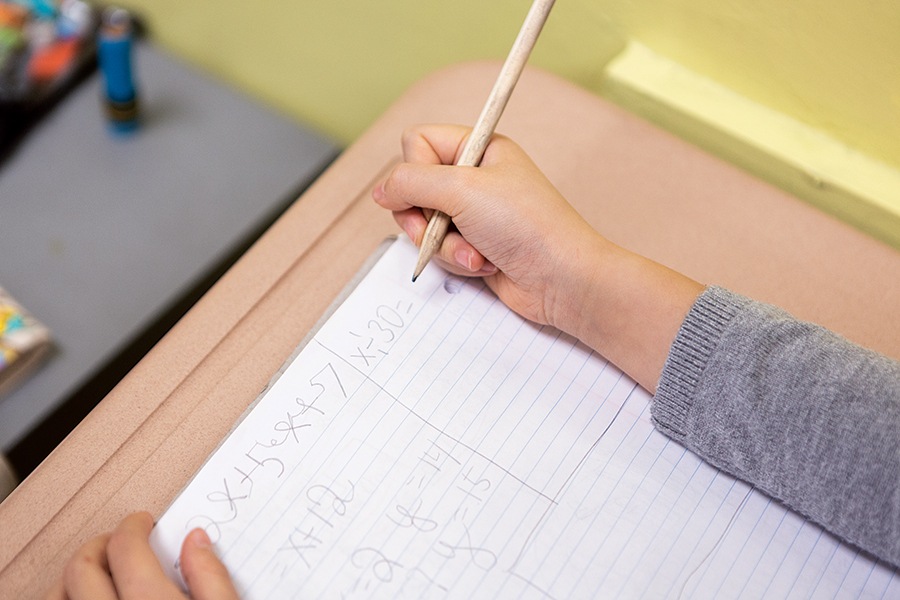
Parents of RSM students note with pride that their kids are two or three years ahead of their peers. / Photo by Jason Grow
Not surprisingly, the popularity of Russian Math has posed a significant challenge for schools, whose teachers now find themselves struggling with how to instruct an increasing number of students who’ve already seen the material. The range in students’ abilities in a single classroom has always been a hurdle for educators. Now that range—and the challenge—is far bigger.
Ultimately, it isn’t just an issue for teachers, but for the very kids who attend RSM. Many of them are bored in math class and have “lost their curiosity,” Kreisberg says, which is an essential part of math. “My experience with students who have engaged in Russian Math is that they oftentimes have this arrogant disposition of, ‘I already know this, I don’t need to learn it again,’ even though they might be missing foundational gaps because they’re so accelerated.” She continues, “They don’t want to learn a different way to solve something. They just want to get to the answer because they can. I have a harder time teaching those students than any other students that I work with.”
It isn’t just RSM kids whose learning in school is affected, but non-RSM kids, too, who begin to question their abilities even if they’re performing perfectly well at grade level. Kreisberg says that when RSM kids in class make rapid-fire calculations, the other students begin to feel they’re not good at math, and that to be good they need to be in the RSM program.
In the worst cases, the Russian Math kids are rude and disrespectful to their teachers. Chu recalls hearing her daughter describe a situation at her high school in which RSM students were constantly correcting and criticizing their regular school teacher. “The word my daughter used,” Chu says, “was ‘insufferable.’”
Kreisberg views the popularity of Russian Math as representative of a general lack of respect for teachers. “Who determines if a child is ‘too advanced’ for their regular school curriculum?” she says. “It’s usually the parents, who are not qualified educators. But they’re not going into hospitals and telling doctors, ‘Hey, you should use this more-advanced procedure because I read about it somewhere.’ Nobody questions what we do in medicine, but we question educators all the time because we don’t value our teachers.” While that’s likely not entirely true—medical professionals have complained about this very problem since the first season of ER—several parents did admit that they enrolled their children in RSM without ever bothering to talk to their kids’ school. “We realized early on that the school didn’t have accommodations for our daughters’ specific level,” Rubio says. “But we never asked the school about it. Because we had RSM.”
At the same time, many RSM parents and students seem to expect teachers to teach to their accelerated level, and at least some schools seem to be complying. According to RSM, Newton South has added new courses and additional levels of math or provided RSM kids with extra homework in order to keep these kids engaged (and their parents happy).
In most cases, though, teachers don’t teach to the RSM kids’ accelerated levels, presumably because they’re busy teaching the rest of the students who are learning on the normal public school schedule. Rubio says one of her daughters was separated out of class for a year. “They would give her a packet with some supposedly more-advanced stuff, and she would go out into the hallway with another girl and do work together,” she says. “And I said, ‘But what do you do if you have a question?’ And she would say, ‘Oh, I just ask [the other girl].’ And I said, ‘What if she has a question?’ And she said, ‘She asks me.’”
RSM also says that other towns, including Weston and Winchester, are taking more-extreme measures. They have started specifically asking parents to refrain from enrolling their children in the Russian School of Mathematics, something that only seems to spark more ire among parents—and which gets tricky when teachers from those districts are spotted dropping off their own kids there. (None of the schools mentioned in this article, nor many others contacted for this story, responded to repeated requests for comment.) Star thinks schools could do a better job communicating their plan for attending to advanced children’s math instruction needs, instead of just discouraging enrollment in RSM. “But maybe in some communities,” he says, “it already feels like they lost the battle.”
There is also the issue of elitism. RSM says that classes start at $20 an hour, which may be a handy way of making it sound affordable; tuition for most students is at least $2,000 per course. It is likely not a coincidence that its locations are all in upper-middle-class towns. According to a 2019 report about after-school math from Pioneer Education, all but one of the Massachusetts towns where RSM has locations have a median household income of $93,600 or more, compared to the statewide average of $67,800; five are among the 20 Massachusetts communities with the highest median income. While Kumon has partnered with schools in inner cities to provide its program to low-income families, RSM has no similar program. (It does, however, offer financial aid to 10 to 15 percent of its students.)
Chu says that in middle school, her daughter’s teachers were openly critical of RSM’s elitist nature, and Chu doesn’t disagree with them. Neither does Wyle, saying, “I understand why [the schools] would have that defensive position, because it’s tough for them when they have some significant cohort in their class who are getting this world-class math education, and then there’s everybody else. But from my perspective, I never would have been at the Russian School of Mathematics if it hadn’t been for Weston’s bad math curriculum.”
On a Saturday morning in late January, the lobby at RSM’s Newton headquarters has become the new soccer-field sidelines: Moms in Canada Goose parkas chat animatedly, clutching Yeti mugs, as sleepy kids shuffle into their respective classrooms. The parking lot is a showroom of Range Rovers and white Audis. “My God, we spent so much money on it,” says mom Maria Rubio of the years her two daughters attended RSM. “But it is amazing.”
